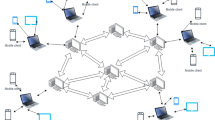Abstract
Peer-to-Peer (P2P) networks are less expensive, simple to use, and do not require the traditional client–server model. It has particular advantages in data sharing and resource utilization, so it is recommended to use it for various applications. P2P networks have been used in many applications, especially in data sharing and resource utilization. Load balancing and security is an essential task to improve the performance of P2P networks. Hence, in this paper, probability-based load balancing control and security enhancement is developed in P2P networks. The probability of peer can be computed with chicken swarm optimization (CSO), which selects the best peer in P2P networks to achieve load balancing and resource utilization. The proposed method is developed to attain two main objective functions: load balancing control and security enhancement. A probability-based CSO algorithm is used to control load balancing. The security is achieved with Enhanced Rumour Riding protocol (ERR) and SXOR (Split XOR) operation. The proposed method is implemented in the NS2 platform, and the performance of the proposed method is analysed with performance metrics such as delay, delivery ratio, packet loss, encryption time, decryption time, and throughput. The proposed method is compared with existing methods such as Biased Contribution Index based Rumour Riding protocol (BCIRR), Ant Colony Optimization (ACO), and Catching Algorithms (CA). The proposed technique achieves a 98.75% packet delivery ratio, with a minimum 3.8 s delay. Ultimately the performance suggests that the proposed system can perform better for load balancing and security in the P2P network.





















Similar content being viewed by others
Abbreviations
- P:
-
Peer
- nr :
-
Best fitness
- nc :
-
Worst fitness
- f :
-
Fitness value
- X :
-
Position
- k :
-
Rooster index
- \(\varepsilon\) :
-
Small constant value
- R2 and R1 :
-
Index value of chicken and hens groupmate
- Random :
-
Random number over [0, 1]
- \({X}_{s,b}^{T}\) :
-
Position of chick’s mother
- fl :
-
Random value between 0 and 2
References
Dhungana A, Bulut E (2020) Peer-to-peer energy sharing in mobile networks: Applications, challenges, and open problems. Ad Hoc Netw 97:102029
Masinde N, Graffi K (2020) Peer-to-peer based social networks: A comprehensive survey. Preprint at arXiv:2001.02611
Djellabi B, Younis M, Amad M (2020) Effective peer-to-peer design for supporting range query in Internet of Things applications. Comput Commun 150:506–518
He H (2020) A reliable peer-to-peer storage framework based on the virtual peers model. Int J Networking Virtual Organ 22(2):129–146
Hou WJ, Jiang Y, Lei W, Xu A, Wen H, Chen S (2020) A P2P network-based edge computing intelligent grid model for efficient resources coordination. Peer-to-peer Netw App 1–12
Khalid R, Javaid N, Almogren A, Javed MU, Javaid S, Zubair M (2020) A blockchain based load balancing in decentralised hybrid P2P energy trading market in smart grid. IEEE Access
Sina M, Dehghan M, Rahmani AM, Reshadi M (2020) WidePLive: A coupled low-delay overlay construction mechanism and peer-chunk priority-based chunk scheduling P2P live video streaming. IET Commun 14(6):937–947
Premarathne US, Rajasingham S (2020) Trust based multi-agent cooperative load balancing system (TCLBS). Futur Gener Comput Syst
Özsu MT, Valduriez P (2020) Peer-to-peer data management. In: Principles of Distributed Database Systems. Springer, Cham, pp 395–448
Berenjian S, Hajizadeh S, Hatamian M, Atani RE (2019) An incentive security model to provide fairness for peer-to-peer networks. Preprint at arXiv:1906.09355
Goswami A, Gupta R, Parashari GS (2017) Reputation-based resource allocation in P2P systems: A game theoretic perspective. IEEE Commun Lett 21(6):1273–1276
Li S, Sun W (2016) A mechanism for resource pricing and fairness in peer-to-peer networks. Electron Commer Res 16(4):425–451
Alhussain A, Kurdi H (2018) EERP: An enhanced eigen trust algorithm for reputation management in peer-to-peer networks. Procedia Computer Science 141:490–495
Jamal AA, Teahan WJ (2017) Alpha multipliers breadth-first search technique for resource discovery in unstructured peer-to-peer networks. Int J Adv Sci Eng Inf Technol 7(4):1403–1412
Han Q, Wen H, Feng G, Wu B, Ren M (2016) Self-nominating trust model based on hierarchical fuzzy systems for peer-to-peer networks. Peer-to-Peer Netw App 9(6):1020–1030
Singh M, Kumar C, Nath P (2020) Finger forwarding scheme to reduce lookup cost in structured P2P networks. Wireless Pers Commun 114:2263–2281
Masinde N, Bischoff S, Graffi K (2020) Capacity management protocol for a structured P2P-based online social network. In: 2020 Seventh International Conference on Social Networks Analysis, Management and Security (SNAMS). IEEE, pp 1–8
Shu Y, Zhu F (2020) An edge computing offloading mechanism for mobile peer sensing and network load weak balancing in 5G network. J Ambient Intell Humaniz Comput 11(2):503–510
Rahmani M, Benchaïba M (2019) PCSM: an efficient multihop proximity aware clustering scheme for mobile peer-to-peer systems. J Ambient Intell Humaniz Comput 10(11):4243–4260
Gomathi S, Manimegalai D (2019) Hierarchically distributed peer-to-peer architecture for load balancing and effective dynamic group scheduling in grid computing. Int J Bus Inform Syst 32(3):312–323
Milani AS, Navimipour NJ (2016) Load balancing mechanisms and techniques in the cloud environments: Systematic literature review and future trends. J Netw Comput Appl 71:86–98
Neghabi AA, Navimipour NJ, Hosseinzadeh M, Rezaee A (2019) Nature‐inspired meta‐heuristic algorithms for solving the load balancing problem in the software‐defined network. Int J Commun Syst 32(4):e3875
Seo JH, Kim YH (2020) A peer load balancing method for P2P-assisted DASH Systems. J Broadcast Eng 25(1):94–104
Mohammadi B, Navimipour NJ (2019) Data replication mechanisms in the peer‐to‐peer networks. Int J Commun Syst 32(14):e3996
Shen L, Wu J, Wang Y, Liu L (2018) Towards load balancing for LSH-based distributed similarity indexing in high-dimensional space. In 2018 IEEE 20th International Conference on High Performance Computing and Communications; IEEE 16th International Conference on Smart City; IEEE 4th International Conference on Data Science and Systems (HPCC/SmartCity/DSS), IEEE, pp 384–391
Qi X, Qiang M, Liu L (2020) A balanced strategy to improve data invulnerability in structured P2P system. Peer-to-Peer Netw and App 13(1):368–387
Rguibi MA, Moussa N (2018) Hybrid trust model for worm mitigation in P2P networks. J Inform Secur App 43:21–36
Chuang Y-T, Li F-W (2020) TCR: a trustworthy and churn-resilient academic distribution and retrieval system in P2P networks. J Supercomput 1–33
Elrotub M, Bali A, Gherbi A (2021) Sharing VM resources with using prediction of future user requests for an efficient load balancing in cloud computing environment. Int J Softw Sci Comput Intel (IJSSCI) 13(2):37–64
Manasrah AM, Gupta BB (2019) An optimized service broker routing policy based on differential evolution algorithm in fog/cloud environment. Clust Comput 22(1):1639–1653
Ahuja SP, Czarnecki E, Willison S (2020) Multi-factor performance comparison of amazon web services elastic compute cluster and google cloud platform compute engine. Int J Cloud App Comput (IJCAC) 10(3):1–16
Chui KT, Gupta BB, Liu RW, Vasant P (2021) Handling data heterogeneity in electricity load disaggregation via optimized complete ensemble empirical mode decomposition and wavelet packet transform. Sensors 21(9):3133
Ali S, Banerjea S, Pandey M, Tyagi N (2019) Towards DHT-Based P2P Resource Sharing Over Hybrid Infrastructure of Wireless Mesh Network and Mobile Ad hoc Networks. In Computing and Network Sustainability, Springer, Singapore, pp 147–155
Asghari S, Navimipour NJ (2019) Cloud service composition using an inverted ant colony optimisation algorithm. Int J Bio-Inspired Comput 13(4):257–268
Souri A, Navimipour NJ (2014) Behavioral modeling and formal verification of a resource discovery approach in Grid computing. Expert Syst Appl 41(8):3831–3849
Asghari S, Navimipour NJ (2019) Resource discovery in the peer to peer networks using an inverted ant colony optimisation algorithm. Peer-to-Peer Netw App 12(1):129–142
Wang B, Li W, Chen X, Chen H (2019) Improved chicken swarm algorithms based on chaos theory and its application in wind power interval prediction. Math Prob Eng 2019
Deb S, Gao X-Z, Tammi K, Kalita K, Mahanta P (2020) A new teaching–learning-based chicken swarm optimization algorithm. Soft Comput 24(7):5313-d5331
Christo MS, Meenakshi S (2016) Reliable and authenticated rumor riding protocol for unstructured peer-to-peer network. Indian J Sci Technol 9(21):1–9
Christo MS, Meenakshi S (2018) Enhancing rumor riding protocol in P2P network with cryptographic puzzle through challenge question method. Comput Electr Eng 65:122–138
Li Y, Gai K, Qiu L, Qiu M, Zhao H (2017) Intelligent cryptography approach for secure distributed big data storage in cloud computing. Inf Sci 387:103–115
Siddaramappa V, Ramesh KB (2019) DNA-Based XOR operation (DNAX) for data security using DNA as a storage medium. In Integrated Intelligent Computing, Communication and Security, Springer, Singapore, pp 343–351
Anupriya E, Soni S, Agnihotri A, Babelay S (2011) Encryption using XOR based extended key for information security–a novel approach. Int J Comput Sci Eng (IJCSE) 3(1):146–154
Ayyasamy S, Sivanandam SN (2010) A cluster based replication architecture for load balancing in peer-to-peer content distribution. Preprint at arXiv:1009.4563
Funding
This research did not receive any specific grant from funding agencies in the public, commercial, or not-for-profit sectors.
Author information
Authors and Affiliations
Contributions
The corresponding author claims the major contribution of the paper including formulation, analysis and editing. The Second author guides to verify the analysis result and manuscript editing.
Corresponding author
Ethics declarations
Informed consent
Informed consent was obtained from all individual participants included in the study.
Conflict of interest
There is no conflict of Interest between the authors regarding the paper preparation and submission of a manuscript.
Additional information
Publisher's Note
Springer Nature remains neutral with regard to jurisdictional claims in published maps and institutional affiliations.
Rights and permissions
About this article
Cite this article
Kumar, D., Pandey, M. An optimal load balancing strategy for P2P network using chicken swarm optimization. Peer-to-Peer Netw. Appl. 15, 666–688 (2022). https://doi.org/10.1007/s12083-021-01259-3
Received:
Accepted:
Published:
Issue Date:
DOI: https://doi.org/10.1007/s12083-021-01259-3




